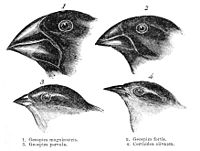
Photo from wikipedia
Abstract The number and placement of meiotic crossover events during meiosis have important implications for the fidelity of chromosome segregation as well as patterns of inheritance. Despite the functional importance… Click to show full abstract
Abstract The number and placement of meiotic crossover events during meiosis have important implications for the fidelity of chromosome segregation as well as patterns of inheritance. Despite the functional importance of recombination, recombination landscapes vary widely among and within species, and this can have a strong impact on evolutionary processes. A good knowledge of recombination landscapes is important for model systems in evolutionary and ecological genetics, since it can improve interpretation of genomic patterns of differentiation and genome evolution, and provides an important starting point for understanding the causes and consequences of recombination rate variation. Arabidopsis arenosa is a powerful evolutionary genetic model for studying the molecular basis of adaptation and recombination rate evolution. Here, we generate genetic maps for 2 diploid A. arenosa individuals from distinct genetic lineages where we have prior knowledge that meiotic genes show evidence of selection. We complement the genetic maps with cytological approaches to map and quantify recombination rates, and test the idea that these populations might have distinct patterns of recombination. We explore how recombination differs at the level of populations, individuals, sexes and genomic regions. We show that the positioning of crossovers along a chromosome correlates with their number, presumably a consequence of crossover interference, and discuss how this effect can cause differences in recombination landscape among sexes or species. We identify several instances of female segregation distortion. We found that averaged genome-wide recombination rate is lower and sex differences subtler in A. arenosa than in Arabidopsis thaliana.
Journal Title: Genetics
Year Published: 2022
Link to full text (if available)
Share on Social Media: Sign Up to like & get
recommendations!